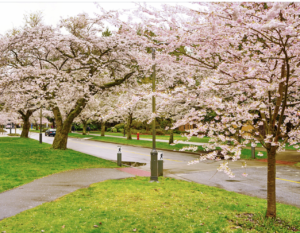Anúncios
To relieve discomfort, rural Estonians have used smoke saunas for generations. They are a profound experience that clears the mind and spirit
I’m nude on a seat in a smoke sauna on a rare bright March day in Estonia. A sooty wooden beam supports my feet and a viht supports my head. I’m using this thin oak branch bundle as a cushion instead of lashing my naked body to remove dead skin and increase circulation. After soaking, dry leaves are flexible. Smoke and earthy fragrance enter my nose. My body is covered with perspiration from the humid air.
Mooska Smoke Sauna proprietor Eda Veeroja is nude. She pours water over heated pebbles on the brick stove. “Olen tuul üle väljade… I am the breeze over the meadows… She sings, “I hold you, I hold you,” with a lullaby music, leil lyrics, and rock steam.
Anúncios
As the crow flies, Mooska is 20km from the Russian border in southeast Estonia. It belongs to Vana Võromaa, also known as Old Võromaa, which includes portions of Võru, Polva, Tartu, and Valga counties. Võro, a Finno-Ugric language close to Estonian, originated in this isolated hilly area with over 70,000 native speakers.
The sauna has been prepared for eight hours by Veeroja. The steam room burner was fed logs for six hours of heating. A smoke sauna has no chimney, so the steam chamber is filled with smoke and the hot air rises to the ceiling, leaving just enough clean air below for her to keep feeding the fire. After the sauna reached 80C, she opened a ceiling hatch to ventilate it for two hours before we entered.
Anúncios
Saunas have been in northern Europe for millennia. Ancient Estonian houses were tiny chimney-less constructions with a burner in the corner, so they could be saunas or residences. In the 1980s, an excavation in northern Estonia revealed the first archeological evidence of a purpose-built, stand-alone sauna from the 12th to 13th centuries, presumably predating the first documented reference of “saun” in 1241.
Germanic culture overwhelmed local trade and religion after the Northern Crusades, and Baltic Germans made up most of Estonia’s landed aristocracy, even though the Danes, Swedes, and Russian Empire ruled Estonia. Masons created “smokeless stoves” (stoves with chimneys) for rich townspeople and urban bathhouses in the Middle Ages.
The 2023 book Sauna: History, Culture, Health and Construction states that native Estonian culture, including sauna culture, was preserved for 700 years, particularly in South Estonia, apart from Hanseatic cities and trade lines. Peasant living improved little for centuries, and South Estonian saunas were generally chimneyless until the 1920s.
He traveled across Estonia and Europe when the Soviet Union’s occupation ended in 1991. She realized that urbanization and electric heating had modified sauna traditions. Võromaa’s smoke saunas had a deep quality that others had lost, and she realized she had something unique to give in her own garden.
Veeroja initiated the Unesco listing of Võromaa’s smoke sauna culture in 2009, and it was included to the list of Intangible Cultural Heritage in 2014. The section covers the smoke sauna structure, its construction and restoration, and associated practices including smoking meat in the sauna, celebrating and healing, and manufacturing viht.
The Anna Hints-directed Smoke Sauna Sisterhood debuted smoke saunas internationally last year. Hints, from Võru, documented the experiences of a group of ladies visiting smoke saunas in South Estonia, particularly Mooska, for seven years. In the film, smoke saunas are confessionals. Woman open up. They sing, weep, and hold space in stillness. Hints called the smoke sauna the “cosmic womb” that holds and heals.
After nearly nine years in Estonia, I’ve been to many saunas, but none a smoke sauna. I didn’t mind the heat or nakedness. Even the prospect of a frigid plunge between sweating bouts was exciting. I was apprehensive about the smoke sauna’s “soul”.
Hints told me on video that saunas, particularly smoke saunas, may be spiritual practices before my vacation to Mooska.
Anna Hints: Granny always said that in the smoke sauna, you cleanse your body and soul
“It has always been therapeutic…” Heat causes physical and mental debris to rise from deeper levels to the surface. You’re hot enough to sweat. You have water to wash it away “Said Hints. “Granny always used to say that in the smoke sauna, you wash not just your body, but you also wash your soul.”
I scrub with ash, sweat, and rinse in an ice-covered pond at Mooska. Returning to the sauna, I apply honey, lash my body from head to toe with viht, and submerge myself in the pond again. I laid on my stomach for Veeroja to apply viht to my back in the sauna again.
I unwind in the cozy break area by the wood-burning stove between sweating. In a unique blend of history and meditation, Veeroja discusses Võromaa’s smoke sauna traditions as I enjoy hot tea and maple syrup from nearby trees. I have lost track of time because I have never looked at my phone.
Estonians used to term sauna-going a time to unwind and socialize after a week of hard labor, not a mindfulness exercise. Since South Estonian peasants couldn’t see the doctors who treated their affluent landowners and manor people, they used the sauna to cure their ailments.
Most people go to the doctor when unwell, but Veeroja, like Hints, thinks the sauna can alleviate contemporary society’s spiritual ailments. The sauna at Mooska focuses on mental advantages, while heat treatment has been demonstrated to boost circulation and immunological response.
Even though goose wings were historically used to beat cross-eyed visitors and ferns to dispel bad curses, Mooska no longer does either. Sauna greetings and thanks continue. Give sauna-goers time to relax. Scrubbing with ash exfoliates and links the mind to body feelings. “People who have been never in sauna before, but who do regular spiritual practices, like yoga or meditation, then they feel at home in the sauna,” Veeroja. “If somebody finds comfort and likes what we do in a smoke sauna, then [smoke sauna] can spread as wide as yoga culture.”
With Unesco’s cultural cache and Hints’ film’s success, Estonians are returning to their origins and utilizing the smoke sauna to slow down and reconnect with family and environment while seeing the economic benefits of conserving this old tradition.
Anti Konsap, 36, lived in a sauna with his elder brother for two years while his parents built their home in his teens. Konsap loved saunas even if those years were lonely and dreary. Even during his military duty, weekly saunas relieved tension as they did for agricultural laborers. He saved the walls of a smoke sauna from destruction and paid a constructor to rebuild it in a birch forest area south of Võru last year. The smoke sauna is his passion project, which he wishes to share with Estonian visitors.
I asked Konsap whether a smoke sauna connects him to the past. He confirms, “I’m not religious, but the sauna is a nice location to communicate to ghosts. You remember your grandparents and ancestors. You may meet ancient spirits there.”
Although I’m not religious, I believe the sauna is an excellent location to communicate to spirits – Anti Konsap
I don’t converse to ghosts in Mooska’s gloomy sauna. If I believed in them, they’d be in the US, where I’m from, not Estonia. However, I am in Estonia. English-chanting Veeroja says, “You are whole; you are enough.” I may not be cured, but I feel entire and great in my body and in this environment. That’s enough.






